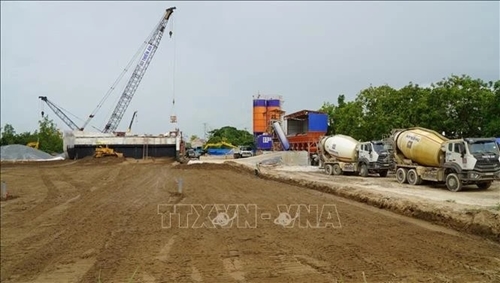This goal is expected to serve as a driving force to create new development spaces, industrial zones, urban areas, and increased land value, while generating more jobs and sustainable livelihoods for the people of the delta region in particular and the country as a whole.
Accelerating progress, addressing bottlenecks
According to the People’s Committee of Dong Thap province, the first phase of the Cao Lanh - An Huu Expressway Project requires about 2.3 million cu.m of sand. To meet this demand, the provincial Transportation Construction Project Management Board has proposed that the Department of Natural Resources and Environment (now the Department of Agriculture and Environment) advise the provincial People’s Committee to allow continued extraction of unutilized sand volumes from 2024 into 2025.
During the project’s implementation, provincial leaders and relevant departments have made significant efforts to resolve challenges, particularly in land clearance and sand supply. These issues are gradually being addressed, with contractors working tirelessly overtime and even through holidays and festivals, to ensure the project remains on schedule.
    |
 |
|
Construction of the Cao Lanh – An Huu Expressway, Section 1, passing through Nhi My commune, Cao Lanh district, Dong Thap province |
Given the strategic importance of transport infrastructure in the Mekong Delta, the Prime Minister has directly convened numerous meetings with ministries and local authorities since the beginning of his term. He has conducted on-site inspections, encouraged workers and contractors, and ensured resettlement and the livelihoods of affected communities are properly managed.
In response to material shortages, the Prime Minister has directed provincial authorities with stone reserves to prioritize and expedite coordination with investors to ensure supply. Provinces with sand reserves, such as Tien Giang, Ben Tre, Vinh Long, Dong Thap, Soc Trang, and An Giang, are to apply all possible mechanisms and policies to fulfill supply targets and commitments in terms of volume and extraction capacity.
Project investors, management boards, contractors, and supervising consultants have been urged to stay closely involved, proactively working with local authorities and departments to accelerate the supply of essential materials for embankment and roadbed construction.
In Dong Thap, the provincial authorities have launched an emulation movement titled, “Accelerating the Completion of Phase 1 of the Cao Lanh - An Huu Expressway.” Responsibilities have been clearly assigned to relevant organixsations and individuals to ensure the project is completed on time and meets quality standards.
A vision for the future
Dr. Tran Huu Hiep, former Director of the Economic Department of the former Steering Committee of the Southwest region, emphasized that transport development must align with logistics infrastructure and broader regional development initiatives. A clear, systematic approach is needed, ensuring integration in both planning and execution, while avoiding fragmented, localized efforts.
The Mekong Delta region must also blend public investment with mechanisms to attract private and social capital. Regional coordination mechanisms for transport planning should be enhanced, prioritizing inter-provincial and inter-regional projects, especially those linking the Delta with Ho Chi Minh City and the Southern Key Economic Region.
To Hoai Phuong, Chairman of the People’s Committee of Ca Mau city in the same name province, highlighted the province’s strategic role as a vital transport and economic gateway. It connects major highways such as National Routes 1 and 63 and the Southern Coastal Corridor, while also serving as a key defense and security point. By 2045, Ca Mau aims to develop into a polycentric urban area based on a radial axis model, with well-distributed urban cores linked via transport and functional zones.
In Dong Thap Muoi area, Dong Thap province seeks to develop an efficient and synchronized transport network extending from urban to rural areas, facilitating the smooth flow of goods and passengers. This supports economic growth, urban development, rural modernization, and national defense and security.
The province is prioritizing the completion of critical connections linking Dong Thap with the national transport network, inter-regional routes, key intra-provincial roads, urban corridors, and access routes to industrial zones and major raw material areas. Land-use planning along these roads is being coordinated to stimulate local economic development. Public-private partnerships and diversified investment sources are being actively promoted.
The PM has stressed the need for the Mekong Delta region to develop rapidly and sustainably, contributing meaningfully to national growth. He noted the importance of drawing lessons to enhance performance in the future.
Amid challenges like land subsidence, erosion, and saltwater intrusion, the government leader has tasked ministries and agencies with implementing a comprehensive response plan. He also emphasized the rollout of the 1 million hectares of high-quality, low-emission rice project, and the ongoing expansion and improvement of Phu Quoc, Ca Mau, and Rach Gia airports, as well as seaports such as Cai Cui, Tran De, and Hon Khoai, laying the groundwork for new development opportunities.
While the Mekong Delta region still faces many difficulties, PM Pham Minh Chinh affirmed its development prospects are bright. Robust transport infrastructure will be key to reducing logistics costs, enhancing the region’s competitiveness, and unlocking vast new growth potential for the Mekong Delta region and the nation as a whole.
Source: VNA